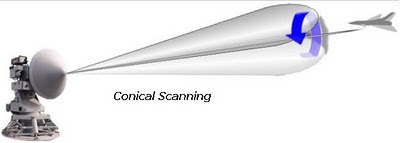Conical scanning is a tracking system used in early radars units by which one could generate a conical scan pattern by using a rotating feed driven by a motor in the housing at the rear of the radar dish. The axis of the radar lobe is made to sweep out a cone in space. The apex of this cone is at the radar transmitter antenna. Conical scanning was used to improve the accuracy of radars, as well as making it easier to properly steer the antenna to point at a target. Conical scanning is similar in concept to the earlier lobe switching concept used on some of the earliest radars, and many examples of lobe switching sets were modified in the field to conical scanning during World War II, notably the German Würzburg radar.
To monitor the direction of a designated target, it is only necessary to keep the aerial pointing directly at the target. Knowledge of the pointing direction of the aerial then naturally gives knowledge of the target direction. In order to keep a single target tracker staring at the designated target automatically, it is necessary to have a control system that keeps the aerial beam pointing at it regardless of the target motion. An apparently obvious method for doing this is to utilise the idea that the radar will get maximum received power when the target is in the beam centre. Circuitry designed to monitor any fall off in received signal strength could be used to control a servo motor that steers the aerial to follow the target motion.
To monitor the direction of a designated target, it is only necessary to keep the aerial pointing directly at the target. Knowledge of the pointing direction of the aerial then naturally gives knowledge of the target direction. In order to keep a single target tracker staring at the designated target automatically, it is necessary to have a control system that keeps the aerial beam pointing at it regardless of the target motion. An apparently obvious method for doing this is to utilise the idea that the radar will get maximum received power when the target is in the beam centre. Circuitry designed to monitor any fall off in received signal strength could be used to control a servo motor that steers the aerial to follow the target motion.
Conical scanning: the target is currently centered on the boresight axis, so it will reflect a signal back to the receiver no matter where the lobe is pointed at that instant (in this case, towards the top). If the target were located slightly above the boresight, a signal would be returned only when the lobe was pointed in that direction. Additionally, since the target is currently located at the edge of the lobe where reception is falling off, when it moves off the boresight the signal will also grow stronger when the lobe is pointed in the right direction.

No comments:
Post a Comment